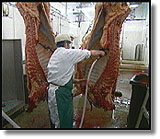
|
Looking good ...
... but is it safe to eat?
|
|
Europe Adopts British-Style BSE Controls
European agriculture ministers have voted to accept the same anti-BSE hygiene rules that apply to cattle slaughtered in British abbatoirs.
The measures include the removal of brains, eyes, tonsils and spinal cords from cattle, sheep and goats, to prevent any tissues infected with BSE, or "mad cow" disease, from entering the human food chain.
The Agriculture Minister, Jack Cunningham, described the outcome as a victory for the UK. He had threatened to ban imports of meat not slaughtered to British standards, which were introduced after the start of the BSE crisis.
Mr Cunningham had argued that is was "absurd" that Britain now had the highest public health standards in Europe but still faced a world-wide beef export ban, while allowing imports of beef from EU partners with less stringent safety checks.

|
|
Setting standards for a messy job
|
The vote however, was decided by the narrowest of margins, with eight votes to seven, short of the qualified majority needed. Now it is up to the European Commission to adopt the hygiene measures. That is considered as likely as the Commission had sponsored the British proposal.
The move was backed by the four countries which have already adopted these strict controls - Britain, Ireland, France and Holland - plus Sweden, Luxembourg, Portugal and Finland.
Minister from some of the other countries had argued that their slaughter houses should not be subjected to the additional hygiene measures as there are no BSE cases in their herds.
Imported beef is taking an increased market share in Britain, partly because of health considerations, partly for price reasons as lower standards in some European slaughter houses generate lower operating costs.
Britain imports a quarter of its beef, most of it from countries which already apply the higher standards.

|


